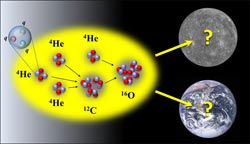Foundations of Carbon-Based Life Leave Little Room for Error

Light quark mass determines carbon and oxygen production and the viability of carbon-based life. Image credit: Dean Lee. Earth and Mercury images from NASA.<br>
Both carbon and oxygen are produced when helium burns inside of giant red stars. Carbon-12, an essential element we’re all made of, can only form when three alpha particles, or helium-4 nuclei, combine in a very specific way. The key to formation is an excited state of carbon-12 known as the Hoyle state, and it has a very specific energy – measured at 379 keV (or 379,000 electron volts) above the energy of three alpha particles. Oxygen is produced by the combination of another alpha particle and carbon.
NC State physicist Dean Lee and German colleagues Evgeny Epelbaum, Hermann Krebs, Timo Laehde and Ulf-G. Meissner had previously confirmed the existence and structure of the Hoyle state with a numerical lattice that allowed the researchers to simulate how protons and neutrons interact. These protons and neutrons are made up of elementary particles called quarks. The light quark mass is one of the fundamental parameters of nature, and this mass affects particles’ energies.
In new lattice calculations done at the Juelich Supercomputer Centre the physicists found that just a slight variation in the light quark mass will change the energy of the Hoyle state, and this in turn would affect the production of carbon and oxygen in such a way that life as we know it wouldn’t exist.
“The Hoyle state of carbon is key,” Lee says. “If the Hoyle state energy was at 479 keV or more above the three alpha particles, then the amount of carbon produced would be too low for carbon-based life.
“The same holds true for oxygen,” he adds. “If the Hoyle state energy were instead within 279 keV of the three alphas, then there would be plenty of carbon. But the stars would burn their helium into carbon much earlier in their life cycle. As a consequence, the stars would not be hot enough to produce sufficient oxygen for life. In our lattice simulations, we find that more than a 2 or 3 percent change in the light quark mass would lead to problems with the abundance of either carbon or oxygen in the universe.”
The researchers’ findings appear in Physical Review Letters.
The work was funded by the U.S. Department of Energy; the Deutsche Forschungsgemeinschaft, Helmholtz-Gemeinschaft Deutscher Forschungszentren and Bundesministerium fuer Bildung und Forschung in Germany; European Union HadronPhysics3 Project and the European Research Council.
-peake-
Note to editors: Abstract follows.
“Viability of carbon-based life as a function of the light quark mass”
Authors: Dean Lee, North Carolina State University; Evgeny Epelbaum and Hermann Krebs, Institut fuer Theoretische Physik II, Ruhr-Universitaet Bochum, Germany; Timo A. Laehde, Forschungszentrum Juelich, Germany; Ulf-G. Meissner, Helmholtz-Institut fuer Strahlen-und Kernphysik and Bethe Center for Theoretical Physics, Universitaet Bonn, Germany
Published: March 13, 2013 in Physical Review Letters
Abstract:
The Hoyle state plays a crucial role in the helium burning of stars that have reached the red giant stage. The close proximity of this state to the triple-alpha threshold is needed for the production of carbon, oxygen, and other elements necessary for life. We investigate whether this life-essential condition is robust or delicately fine-tuned by measuring its dependence on the fundamental constants of nature, specifically the light quark mass and the strength of the electromagnetic interaction. We show that there exist strong correlations between the alpha particle binding energy and the various energies relevant to the triple-alpha process. We derive limits on the variation of these fundamental parameters from the requirement that sufficient amounts of carbon and oxygen be generated in stars. We also discuss the implications of our results for an anthropic view of the Universe.
Media Contact
More Information:
http://www.ncsu.eduAll latest news from the category: Physics and Astronomy
This area deals with the fundamental laws and building blocks of nature and how they interact, the properties and the behavior of matter, and research into space and time and their structures.
innovations-report provides in-depth reports and articles on subjects such as astrophysics, laser technologies, nuclear, quantum, particle and solid-state physics, nanotechnologies, planetary research and findings (Mars, Venus) and developments related to the Hubble Telescope.
Newest articles

Bringing bio-inspired robots to life
Nebraska researcher Eric Markvicka gets NSF CAREER Award to pursue manufacture of novel materials for soft robotics and stretchable electronics. Engineers are increasingly eager to develop robots that mimic the…

Bella moths use poison to attract mates
Scientists are closer to finding out how. Pyrrolizidine alkaloids are as bitter and toxic as they are hard to pronounce. They’re produced by several different types of plants and are…

AI tool creates ‘synthetic’ images of cells
…for enhanced microscopy analysis. Observing individual cells through microscopes can reveal a range of important cell biological phenomena that frequently play a role in human diseases, but the process of…





















